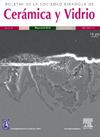从原料粘土到陶瓷:通过成分分析评价原料的适宜性
IF 2.7
4区 材料科学
Q1 MATERIALS SCIENCE, CERAMICS
Boletin de la Sociedad Espanola de Ceramica y Vidrio
Pub Date : 2025-08-05
DOI:10.1016/j.bsecv.2025.100455
引用次数: 0
摘要
几千年来,生粘土一直是一种重要的材料,因其独特的特性和多功能性而受到重视,特别是在陶瓷生产中。因此,本研究试图根据其制造陶瓷建筑材料的适用性对原料粘土进行系统分类。对0.063 mm筛渣、化学成分等关键指标进行了评价,初步、快速评价。根据成分相似性,使用主成分分析(PCA)对来自塞尔维亚的50种原料粘土进行分组,并随后将这些分类与工业样品进行比较。通过对这些群体的矿物组成和加热过程中的行为进行进一步分析,可以全面了解它们的物理行为。结果表明,主成分分析法可以有效地根据原料粘土的化学成分进行分类,为陶瓷生产的可靠分类铺平了道路。该系统使制造商能够优化各种应用的材料,包括普通砖和砌块,屋顶瓦和粘土天花板,瓷砖和耐火制品。主要研究结果表明,含15-20% Al2O3、3-9% Fe2O3和至少2%助熔剂氧化物的原料粘土非常适合生产重质粘土产品。对于瓷砖生产,最佳粘土批次的Fe2O3含量不超过1.5%,TiO2含量不超过1.0%,有机碳含量不超过0.2%。同时,耐火粘土的Al2O3含量必须在15-20%至42%以上,煅烧后SiO2(低于76%)、Fe2O3(3.7%)、Na2O和K2O(3.7%)、CaO(1.0%)为限制条件。通过这种分类框架,制造商可以更有效地选择和精炼原料粘土,以满足陶瓷生产的严格要求,确保工业应用的效率和性能。本文章由计算机程序翻译,如有差异,请以英文原文为准。

From raw clay to ceramics: Evaluating the suitability of raw materials through compositional analysis
Raw clay has been an essential material for thousands of years, valued for its distinctive properties and versatility, particularly in ceramic production. Thus, this study seeks to systematically classify raw clays based on their suitability for manufacturing ceramic building materials. Key indicators such as 0.063 mm sieve residue and chemical composition were evaluated to enable a preliminary and rapid assessment. The 50 raw clays from Serbia were grouped using Principal Components Analysis (PCA) according to compositional similarities, and these classifications were subsequently compared against industrial samples. Further analysis through mineralogical composition and behavior during heating within these groups provided a comprehensive understanding of their physical behavior. The results demonstrate that PCA effectively distinguishes raw clays based on their chemical composition, paving the way for a reliable classification for ceramic production. This system enables manufacturers to optimize materials for diverse applications, including common bricks and blocks, roof tiles and clay ceilings, ceramic tiles, and refractory products. Key findings reveal that raw clays containing 15–20% Al2O3, 3–9% Fe2O3, and at least 2% fluxing oxides are well-suited for heavy clay products. For ceramic tile production, optimal clay batches should contain no more than 1.5% Fe2O3, 1.0% TiO2, and less than 0.2% organic carbon. Meanwhile, refractory clays must exhibit a minimum of 15–20% and up to over 42% Al2O3, with constraints on SiO2 (below 76%), Fe2O3 (3.7%), Na2O and K2O (3.7%), and CaO (1.0%) after firing. Through this classification framework, manufacturers can more effectively select and refine raw clays to meet the stringent demands of ceramic production, ensuring both efficiency and performance in industrial applications.
求助全文
通过发布文献求助,成功后即可免费获取论文全文。
去求助
来源期刊

Boletin de la Sociedad Espanola de Ceramica y Vidrio
工程技术-材料科学:硅酸盐
CiteScore
5.50
自引率
2.90%
发文量
72
审稿时长
103 days
期刊介绍:
The Journal of the Spanish Ceramic and Glass Society publishes scientific articles and communications describing original research and reviews relating to ceramic materials and glasses. The main interests are on novel generic science and technology establishing the relationships between synthesis, processing microstructure and properties of materials. Papers may deal with ceramics and glasses included in any of the conventional categories: structural, functional, traditional, composites and cultural heritage. The main objective of the Journal of the Spanish Ceramic and Glass Society is to sustain a high standard research quality by means of appropriate reviewing procedures.
 求助内容:
求助内容: 应助结果提醒方式:
应助结果提醒方式:


